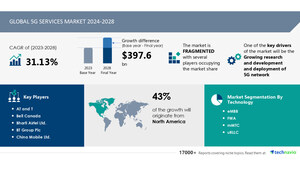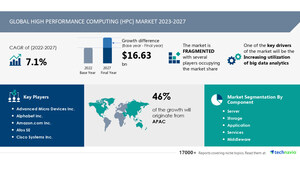NEW YORK, March 4, 2024 /PRNewswire/ -- The factoring market is estimated to grow by USD 1.72 billion from 2022 to 2027, growing at a CAGR of 7.54%. The factoring market is fragmented owing to the presence of many global and regional companies. A few prominent companies that offer factoring market are ABS Global Factoring AG, American Receivable, Bluevine Inc., CapitalPlus Construction Services, CG24 Group AG, Charter Capital Holdings LP, Deutsche Leasing AG, eCapital Corp., Eurobank Ergasias SA, Factor Funding Co., FirstRand Ltd, HSBC Holdings Plc, Mizuho Financial Group Inc., New Century Financial Inc., PMFBancorp, Riviera Finance of Texas Inc., Societe Generale SA, The Southern Banc Co. Inc., Triumph Business Capital, and Universal Funding Corp. The report provides a full list of key companies, their strategies, and the latest developments. View PDF Sample
Report Coverage |
Details |
Page number |
156 |
Base year |
2022 |
Historic period |
2017-2021 |
Forecast period |
2023-2027 |
Growth momentum & CAGR |
Accelerate at a CAGR of 7.54% |
Market growth 2023-2027 |
USD 1,720.41 billion |
Market structure |
Fragmented |
YoY growth (%) |
6.58 |
Regional analysis |
Europe, APAC, South America, North America, and Middle East and Africa |
Performing market contribution |
Europe at 60% |
Key countries |
US, China, UK, France, and Germany |
Company Offering:
- Abs-global-factoring.de - The company provides a range of factoring services including options for start-ups, export businesses, and restructuring. Additionally, the company offers financial and liquidity services under this segment to safeguard against bad debts
- For details on companies and their offerings. Buy a report!
By Geography, the market is classified as Europe, APAC, South America, North America, and Middle East and Africa. Europe will have the largest share of the market. The region is projected to contribute 60% by 2027. In Europe, major banks dominate over 85% of the factoring market, totaling USD 2.0 trillion in turnover for the EU's invoice finance sector in 2020. The EU Federation for Factoring and Commercial Finance (EUF) holds sway, with its members contributing nearly 94% of this turnover, the top five EU countries accounting for about 73% of the market. This industry, representing 12.6% of the EU's GDP, prioritizes fostering accessible and well-structured financing, especially for MSMEs. Efforts by associations like EUF aim to enhance awareness and prudential financing practices across business sectors, fostering positive economic impacts in Europe. View PDF Sample to get more insights on the market share of various regions and the contribution of the segments.
- The growing need for alternative sources of financing for MSMEs
- Advent of blockchain in factoring services
- Lack of a stringent regulatory framework for debt recovery mechanisms in developing countries
Market Segmentation
- The domestic segment will be significant during the forecast period. Domestic factoring involves the factor, buyer, and seller operating within a country's laws, aiding MSMEs with short-term capital against domestic sales. This approach allows sellers to leverage account receivables for funds. This segment, thriving in regions like APAC, Africa, and South America, steadily expands its global market share. With increasing domestic businesses, this sector is poised for rapid growth in the forecasted period within the global factoring services market. Technavio Research experts have provided more insights on the market share of segments. View a Free Sample Report
Analyst Review
The factoring market is a dynamic landscape encompassing a myriad of financial activities that revolve around cash flows, accounts receivable, and financing alternatives. In this ecosystem, firms, ranging from SMEs to large organizations, seek to optimize liquidity and leverage various financial services provided by banks, third-party financial service providers, and fintech solutions.
Factoring, a pivotal aspect of the financial sector, involves the sale of invoices by a seller (often a business) to a factor, typically a third-party financial service provider or a bank. This transaction provides immediate funds to the seller, enabling them to address cash flow needs without waiting for invoice payment from the buyer. The factor then assumes responsibility for collecting payment from the buyer, often charging commission fees or interest for their services.
With the globalization of commerce, factoring has gained traction globally, catering to both domestic and international markets. It presents numerous benefits, including improved cash flow management, confidence in financial stability, and growth opportunities for organizations across industries such as construction, manufacturing, healthcare, transportation & logistics, energy & utilities, and IT & telecom.
Technology, particularly fintech solutions and blockchain platforms like Ethereum, NEO, Hyperledger, and R3CORDA, has revolutionized the factoring market. Automated solutions streamline processes, facilitating bulk payments and reducing the risk of financial frauds. Moreover, technology has bolstered the adoption rate of factoring by offering efficient money transfer and payment mechanisms, enhancing budgeting and financial planning capabilities, and providing robust payment service providers.
In addition to technological advancements, regulatory changes and industry trends shape the factoring landscape, influencing factors such as legal impediments, emerging markets, GDP growth, and financial inclusion. These factors impact the availability of financial support, trade finance, and supply chain finance, thereby affecting the overall growth trajectory of the factoring market.
In conclusion, the factoring market represents a crucial component of the global financial sector, offering essential services to organizations seeking to optimize cash flows and unlock growth opportunities. As technology continues to evolve and regulatory frameworks adapt, the factoring landscape is poised for further innovation and expansion, catering to the diverse needs of businesses worldwide. View a Free Sample Report
Related Reports:
The sharing economy market size is estimated to grow at a CAGR of 28.96% between 2023 and 2028. The market size is forecast to increase by USD 761.76 billion.
The credit intermediation market size is estimated to grow at a CAGR of 2.36% between 2023 and 2028. The market size is forecast to increase by USD 649.87 billion.
TOC:
1 Executive Summary
2 Landscape
3 Sizing
4 Historic Size
5 Five Forces Analysis
6 Segmentations
7 Customer Landscape
8 Geographic Landscape
9 Drivers, Challenges, and Trends
10 Vendor Landscape
11 Vendor Analysis
12 Appendix
Technavio is a leading global technology research and advisory company. Their research and analysis focus on emerging market trends and provide actionable insights to help businesses identify market opportunities and develop effective strategies to optimize their market positions. With over 500 specialized analysts, Technavio's report library consists of more than 17,000 reports and counting, covering 800 technologies, spanning 50 countries. Their client base consists of enterprises of all sizes, including more than 100 Fortune 500 companies. This growing client base relies on Technavio's comprehensive coverage, extensive research, and actionable market insights to identify opportunities in existing and potential markets and assess their competitive positions within changing market scenarios.
Technavio Research
Jesse Maida
Media & Marketing Executive
US: +1 844 364 1100
UK: +44 203 893 3200
Email: [email protected]
Website: www.technavio.com
SOURCE Technavio

WANT YOUR COMPANY'S NEWS FEATURED ON PRNEWSWIRE.COM?
Newsrooms &
Influencers
Digital Media
Outlets
Journalists
Opted In




Share this article